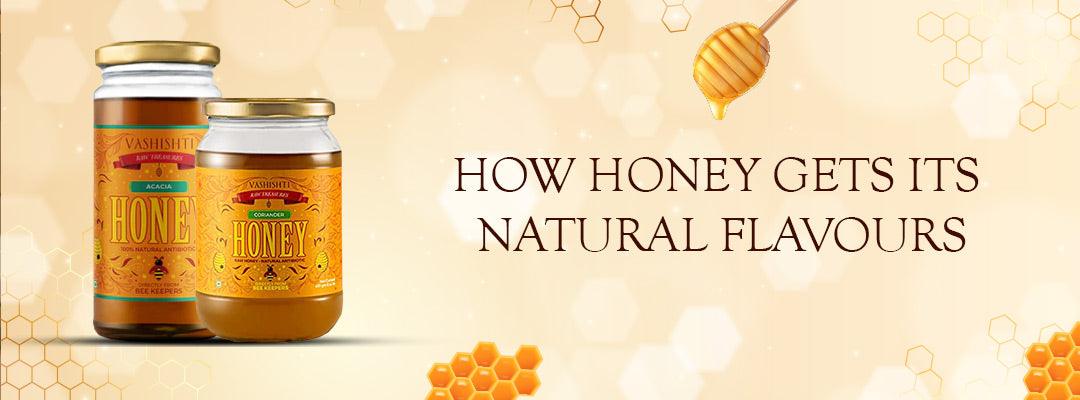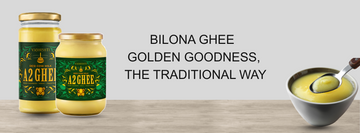Honey comes in a wide range of flavours and fragrances, but not every honey you buy on the market needs to have a natural flavour since many people add synthetic flavours to produce the desired kind of honey. Let's examine the production process for honey to gain a thorough understanding of how honey acquires its flavour organically.
The kind of flowers within about two miles of the hive where the honey is produced determine its flavour. This can be because of the actual fact that honey bees typically forage within a two-mile radius which the kind of flower from which they collect nectar directly affects both the flavour and colour of the honey they produce.
How do honey bees generate honey?
When the flowers are in full bloom, honeybees extract the nectar and pollen from them. As the proteins and enzymes mix with the nectar over time, the nectar is transformed into honey in the stomachs of these animals. The honeybees are now storing the produced honey in the wax combs until they are fully loaded. When the comb is full, the honeybees fan it to remove moisture from the honey, giving it the thick consistency that we all love. Then, a honeybee closes the comb with wax and begins the process once again.
COLOR AND FLAVOR OF HONEY
Where the bees buzz determines the colour and flavour of the honey.
Depending on where the honey bees buzzed, the colour and flavour of honey can range from virtually colourless to dark brown, and from delectably mild to noticeably robust. Honey comes in two broad flavours: light and dark. Light honey has a gentler flavour. Every state produces honey, however different kinds of honey are only made in a few places based on where the floral sources are. Most nations in the world produce honey as well.
Is the flavour of all honey the same?
People frequently bring up the small plastic bottles that are mass-produced and kept on grocery store shelves all around the country when you mention the term "Honey." Most of the "honey" found in store-bought bottles is homogenized and created with the goal of tasting identically. Customers may depend on a consistent product as a result. Unfortunately, it also eliminates all the subtleties and nuanced flavours that more natural honey can provide
- Different Types of Honey
- In terms of flavour, let's analyse how various types of honey differ from one another.Top of Form
1. Acacia honey:
The nectar of the Robinia pseudoacacia flower, sometimes called the black locust or false acacia tree, is used to make acacia honey. It frequently has a considerably lighter colour and seems practically transparent when compared to regular honey .It tastes sweet and delicate with a floral scent. Conveniently, acacia honey keeps liquid longer and crystallizes much slower than regular honey. This is probably because it has more fructose. This honey is quite popular and can cost more than other forms of honey because it doesn't harden as quickly.
2. Ajwain Honey:
Asian spices like ajwain, often called carom seeds in English, are used to flavour a variety of foods. These seeds have a distinctive bitter-pungent flavour. These seeds have numerous advantages that go well beyond their flavour and scent. Weight loss is one of the benefits of these small fruit pods. Since ancient times, ajwain has been utilised as an Ayurveda treatment. It is known to ease constipation, alleviate gas, and encourage good digestion. And everyone is aware that having a healthy digestive system is the first step in losing weight. You can use ajwain in the following three methods to quicken your weight loss programme.
3. Coriander Honey:
It is a relatively uncommon type of honey since it is produced from the tiny coriander blossoms, whose nectar only smaller bees can collect. The best treatment for ulcers, gas, and constipation is honey. The honey, which is made from the flowers of the coria drum saliva plant, has a fresh flavour and is extremely uncommon. As bees, especially honey bees, are brought in to fertilize their cilantro crops, coriander honey naturally comes from nations with large coriander production/exports. Coriander honey, a by-product of that pollination, is frequently sold and disseminated locally and internationally depending on the scale of the enterprise.
4. Chestnut Honey:
Chestnut honey is a monofloral type of honey that has a bitter flavour and dark colour. The nectar from the chestnut trees is extracted by honey bees, who then turn it into honey. Chestnut honey stands out from other honeys thanks to its black colour and slightly bitter flavour. You may have heard that red wine's tart flavour is caused by tannins, which are present in the wine. Because of the tannins in the chestnut tree, this sort of honey has a colour that can range from golden brown to practically black, as well as a bitter flavour. For those who like a less sweet and more nuanced flavour, chestnut honey is ideal. It is frequently served with old cheeses, fresh pears, and robust meat dishes. It has been described as Smokey, leathery, peppery, and enigmatic.
These are some common honey varieties that have excellent therapeutic qualities since they derive those advantages straight from their source, without any adulteration. If you enjoy honey, you'll adore these intriguing things that are manufactured from it.
Visit our site: https://vashishti.com/



